#Temizuya
Text
Jingu of the Spiritual Forest! ⛩️

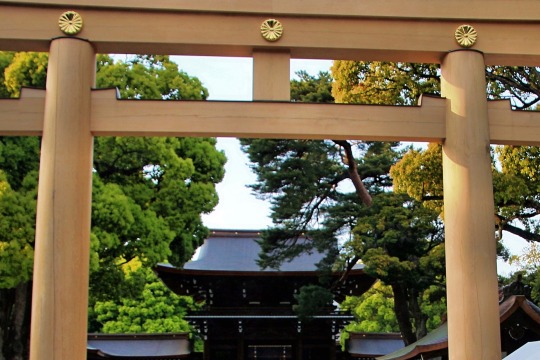

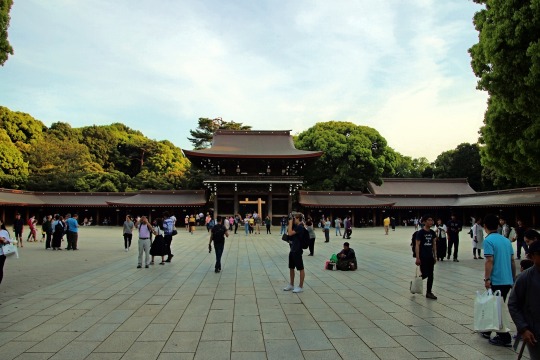
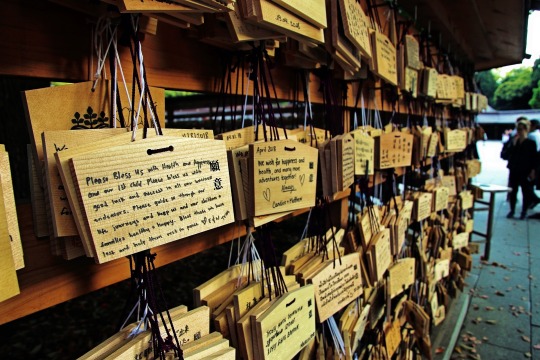
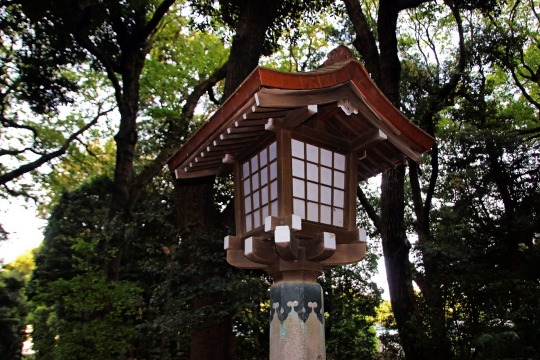
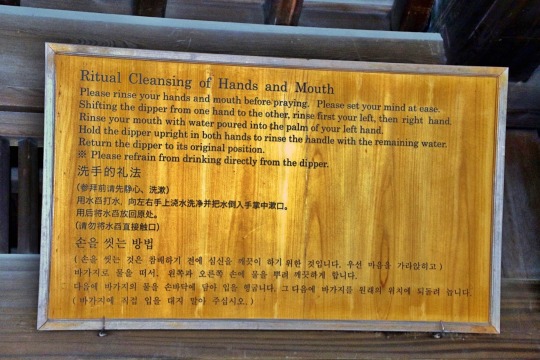

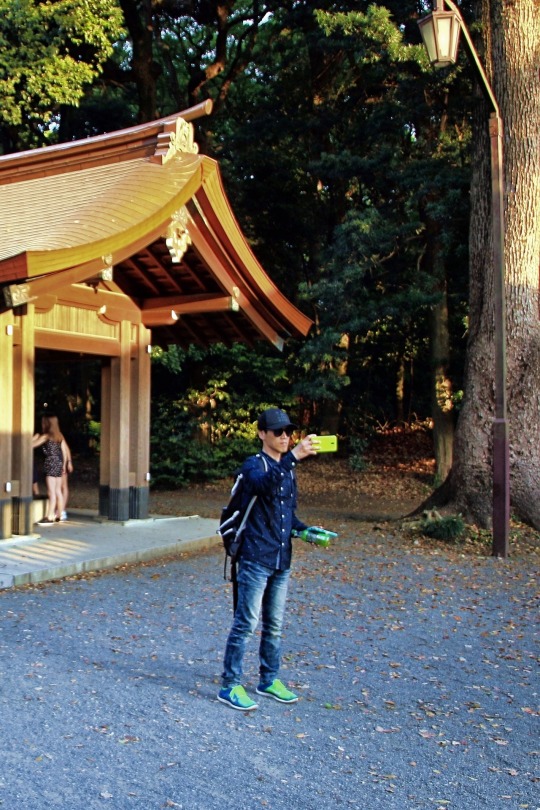
#Meiji Jingu#Shinto Shrine#Torii Gate#Imperial Shrine#Forest#Chozuya#Temizuya#Rituals#Meiji Shrine#Shibuya#Tokyo#Japan
8 notes
·
View notes
Text




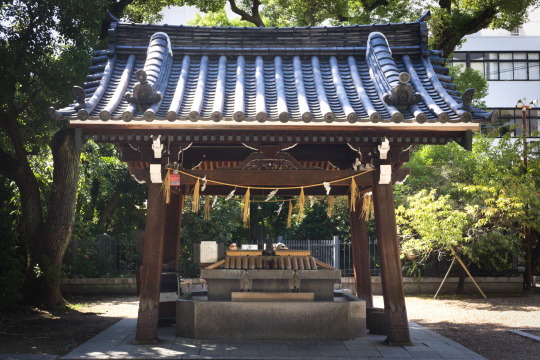
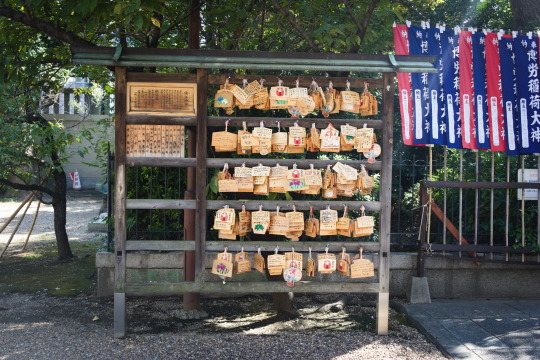
Namba Jinja Shrine, 2023
3 notes
·
View notes
Photo

Temizuya Water Purification at Hiratsuka Hachimangu Shrine
(Hiratsuka-shi, Kanagawa-ken, Japan)
When entering shrine grounds, you need to “purify” yourself before approaching the main worship hall (haiden) of the shrine complex that is open to the public.
As you approach the shrine, there is a small-roofed structure (temizuya) on the left that has a huge stone basin with running water and bamboo ladles (hishaku) resting right above the basin.
After dipping the ladle into the basin, you pour the water over each hand so that the “dirty” water drips down onto the stones placed around the base to catch such water, thus keeping the water in the basin fresh and clean. After this purification ritual, you can then approach the shrine’s haiden worship hall.
Pentax K-1 II + DFA 28-105mm F3.5-5.6
53 mm ISO 100 for 6 sec. at ƒ/10
#風景写真#神奈川県#平塚八幡宮#正しい作法#手水舎#pix4japan#pentax_dfa28105#pentaxk1mkii#Japan#Kanagawa Prefecture#Hiratsuka#Hiratsuka Hachimangu Shrine#chozuya#temizuya#shrine etiquette#Shinto shrine#nightscape photography#urbanscape photography
20 notes
·
View notes
Text
Purification as the Core of the Ancient Shinto Faith | Ancient Origins
Purification as the Core of the Ancient Shinto Faith | Ancient Origins
https://www.ancient-origins.net/history-ancient-traditions/purification-core-ancient-shinto-faith-003108
View On WordPress
#Amaterasu#Buddhism#Chinese Shendao#Hishaku#Izanagi#Izanami#Japan#JapaneseReligions#Jinja#Kagutsuchi#Kami System#Purification Ritual#Shinto#Shintoism#Shrine#Susano#Temizuya#Temple#Tsukuyomi
0 notes
Text
Toman and Buddhism + Tenjiku and Taoism
Another post to cover references in Tokyo Revengers!
This time, I'll be covering the links to two religions to be found in two gangs in the series, reference by reference, with the according explanation of each.
Some of these may be already known, I know one of them sure is (the whole buddhist manji confusion thing yeah yeah) but still, for the sake of a tidy compilation and of providing more detail, I'll go through them too. Some others are a lot less noticed, like Tenjiku's lean towards Tao, so it'll be best to lay down eeeeeeverything I've caught during my time enjoying this series. Plus, I'm pretty excited to get some of those less-known facts out here!!
Warning though, it's lengthy.
Let's start with Tokyo Manji Gang:

- Firstly, the gang's name and how it's written.
Despite Mikey suggesting the name as a short form of Tokyo Manjiro Gang, putting himself front and center, the kanji that ended up forming the name of Tokyo Manji Gang show that it went in a different direction of meaning. The manji used for the middle part ended up not being the same one from the name Manjiro, but a manji written as 卍. Aloud it's read the same way (many, many, many kanji are homophones), but has a different meaning.
卍 (manji) is an extremely common buddhist symbol (not even limited to japanese buddhism, but in hinduism and other aligned east-asian religions too), which represents the path of Buddha and the endless cycle of rebirth through samsara; the pursuit of leading a more spiritually balanced existence until the soul can reach enlightenment. In other words, it's nothing but deeply buddhist.
(To answer a common question around it: can it be called a swastika? Yes. The symbol in general, with each of the million variations that have popped up in different cultures, can be called a swastika as a broad term. There are a fuckton of swastikas. They mean a fuckton of different things. The tilt and the direction in which this one "spins" makes it different from other swastikas though, and it's always best to be precise and call this one manji.)
Moving on,
- Reunion spot.


The Musashi Shrine (based, but not exactly taken from any of the real-life shrines and temples of similar name in Tokyo, as far as I know) is a shinto-buddhist temple. And, apparently, a place where the founders hung out from time to time, but I'll add to that later!!
It's cute to me that the Toman members seem to use the temple very respectfully. They always meet in it at night waaay after it's closed (daytime meetings have always taken place in different locations, never the temple during visiting hours), they've never once set foot even near the oratory/sanctum/other buildings, never been seen bringing the motorcycles anywhere they shouldn't, and the one time a character was seen using the public temizuya (the little stone fountain where visitors purify their hands and mouth), he was proper about it in terms of pouring water into his hand to rinse his mouth with, not getting the ladle or the rest of the water dirty, as one should always do.
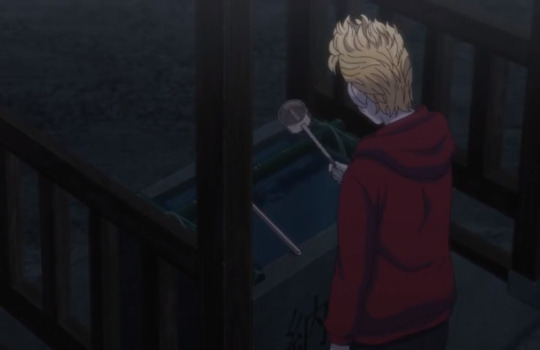
A fun fact: in Google Maps, buddhist temples are marked with the manji symbol!
- Gang's manifesto.

Embroidered on the chest of the gang uniform, you can see the text 天上天下唯我独尊 ("Above the earth and below the heavens, I alone shall be honored"), which is the gang's manifesto or motto. Sounds just like something Mikey would choose, yeah.
That phrase is also of buddhist origin; famously, the words spoken by Buddha Gautama Siddharta (bear in mind that buddhism isn't a religion with one god or anything like that, anyone enlightened can become a Buddha and many figures have been granted that status, but Gautama is the first and main one, the creator of the doctrine) when he was born. To be honest, this is very much interpretative, but I've come to get the impression that it's not so much a power or ego statement, but rather an expression of cultivating and honoring yourself…? It's absolutely up to personal reading and I'm absolutely not an expert. But those are certainly THE Buddha's words.
- Ceremonial sash.

Another part of their uniform that bears a slight reference: the sash worn by the commander, vice-commander, captains and vice-captains during important fights.
These are tasuki, sashes originally worn by shinto-buddhist priests during ceremonies, in order to keep long sleeves and such in place. However, eventually, they also began being worn by samurai and all sorts of warriors, 'cause of their convenience. In modern times, they even started being used by just about anybody who wears traditional clothing but also does manual work and needs the sleeves out of the way. So it can be concluded that, over time, they stopped being strongly linked to religious practicers. In fact, even biker gangs in general ended up adopting the use of tasuki! Not for their religious origins, but for the warrior part; a bōsōzoku gang member wearing one would look very prepared and determined for a fight.
That's why overall, Tokyo Manji Gang having them is only a relative reference; they could be paying homage to their reference religion, as they could be only honoring gang traditions.
- Additional notes about the leader.
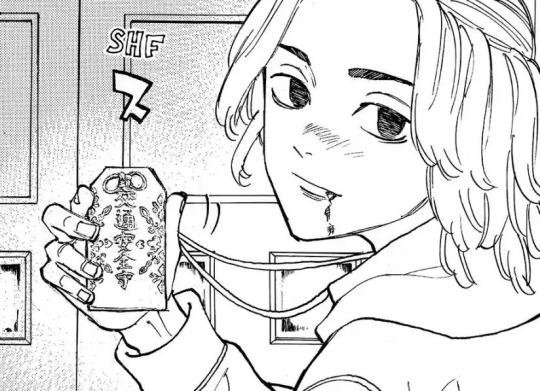
I feel it's important to add up all these little factors of Mikey's choosing, with other little details about him as a person that kinda make it all make sense.
If I say "Mikey seems to be religious, to an extent", I understand this can carry a bunch of tricky connotations. Japanese religion isn't exercised the same way it is in other places, someone being religious SURE AS HECK doesn't mean the same things it means in the christian west. Shinto-buddhism is so commonplace in Japan, most people partake in all kinds of religious practices without even thinking of them as strictly religious, such as new year's celebrations, casual prayer during shrine visits, purchasing and giving charms and such. Religion is integrated in life in a lot of extremely chill ways.
And we can observe a lot of things about Mikey that put him quite above the average in terms of his relationship with local tradition and religion. His house is a huge traditional-style family home, his family is hinted to be active in religious practice (remember Emma's appearances during the Christmas Showdown arc? How she mentioned that their family does a lot of temple visits, and even she considered it weird at that time of the year?), he's much more prone to wearing traditional clothing than his peers, his motif in extra clothing designs is the lion-dog (temple guardians; statues of these can often be found in them), his personal beliefs around death and relationship to the dead run deeper than others' to the point they find him disturbing when he talks about Shinichiro or Baji still being with him... many little things that aren't that deep on their own, of course, but when added up they paint a pretty coherent picture of the guy.
And so, it does make a lot of sense that, even from childhood, a temple was a regular place for Mikey to hang out with his friends, leading to the birth of Toman in one. And it makes a lot of sense that he made all those little choices about the way the gang would be styled. In my opinion, it's likely that those things just all came natural to him because they're a part of his background and worldview. Of course, how actively religious he is, how much he believes in the things he happens to know and how much exactly he might know about buddhism are all up to headcanoning and interpretation. Personally, I'm just a roleplayer that takes it as a relevant part of his character.
- Following a Buddha?
A little out-of-TR-universe element that I love to bring up, 'cause it's just hilarious and cool as hell, is the creation of this statue:
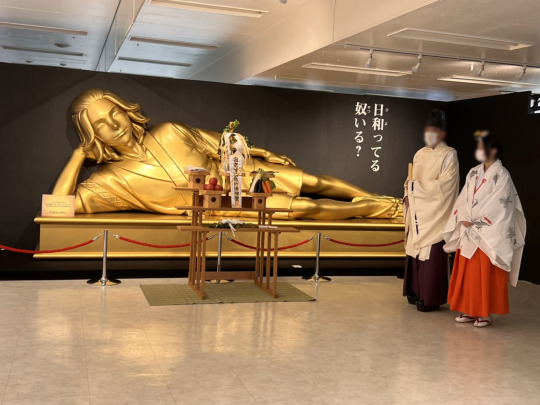
This part of the 2022 Tokyo Revengers exhibition straight up imitates the famous Reclining Buddha in the Wat Pho temple, Thailand.
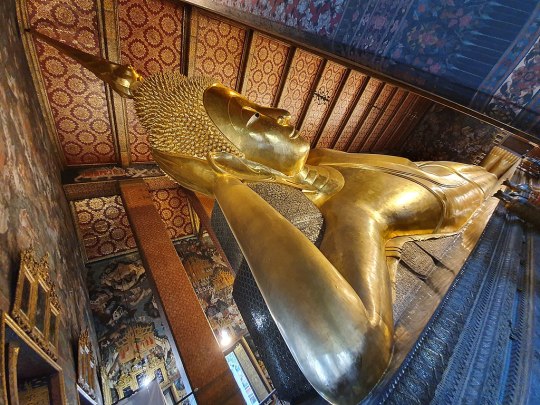
The ENORMOUS statue depicts the moment Buddha reaches nirvana, and his enlightened soul is at rest. The golden Mikey statue that imitates it very much intentionally likens him to a Buddha; funny to note that the exhibition staff even prayed to the statue, as you can read in the tweet itself.
What does this mean about Mikey's character? Well, this isn't within text in Tokyo Revengers, just a little outside factor, so I wouldn't take it too literally or too seriously, but it's interesting nonetheless. Personally, I see it as a hint that Mikey was supposed to be on his own little quest to enlightenment, or had the potential to be. Grappling with morality without having a natural sense of what's right, wrong, too much or enough is a major thing with his character. I can also imagine it might just be meant to represent the godlike view others have of him, the guidance they sought from him. Take it as you will!
The important thing is just that it exists, to confirm that there is an intentional connection of some type between the Buddha and Mikey.
Thaaaaat concludes the Toman and Buddhism section of this post.
Whew!! That was a whole lot.
The Tenjiku and Taoism section coming now is shorter, but I'm sure it contains interesting and less-known things (at least, I've never seen anybody talk about these)!
So let's see, Tao references in Tenjiku:

- Gang name.
Tenjiku is a now-obsolete word that translated directly to "heaven", while simultaneously being the japanese word for the country India (as taken from the chinese pronunciation, Tianzhu).
In modern times, it can be found mostly in ancient literature, the most prominent example being Journey to the West. Given that Kakucho and Izana mentioned this book and seemed to have knowledge of it as kids, we can conclude that's where they got the name of their gang from.
Why would they use the word for India to name their kingdom? What does this have to do with Tao? I'll get into that properly now:
- Kakucho, Izana & Journey to the West.

Journey to the West is one of the four great chinese classic novels (along with Romance of the Three Kingdoms, Outlaws of the Marsh, and Dream of the Red Chamber) which are enormous, ENORMOUS influences on east-asian literature and fiction in general. Journey to the West, itself, is considered the most popular east-asian literary work overall; of course, being super well-known in Japan, too. (To give my favorite funny example of just how omnipresent it is, y'know Dragon Ball? Hit anime series Dragon Ball? Unabashedly based on Journey to the West, which was to thank for most of its initial local popularity.)
It's the story of the buddhist monk Tang Sanzang, who travels to Tenjiku, to India, to that certain heavenly kingdom, to obtain sacred texts for Buddha Gautama Siddharta (the guy I described as THE Buddha in the Tokyo Manji Gang section above). The quest doubles as a search and exercise of enlightenment, as Tang Sanzang is aided by three protectors that are atoning for their sins and learning from him. The main guardian and arguably the true protagonist of the book is Sun Wukong, the Monkey King, a fighter "so strong he could carry a mountain on each shoulder, and still dash as fast as a meteor". It's a huge, epic, 100-chapter monster of a book, in which each chapter is already a fantastic and entertaining anecdote about the characters or what happens in their travels, but also a long spiritual journey that pretty much serves to subtly teach the principles of Tao (term that can be translated to "the path", chinese religion and philosophy).
A tangent: let me just show you how large it is (and why I haven't been able to finish it, 'cause I cannot take this brick of a book anywhere lmaoooo).
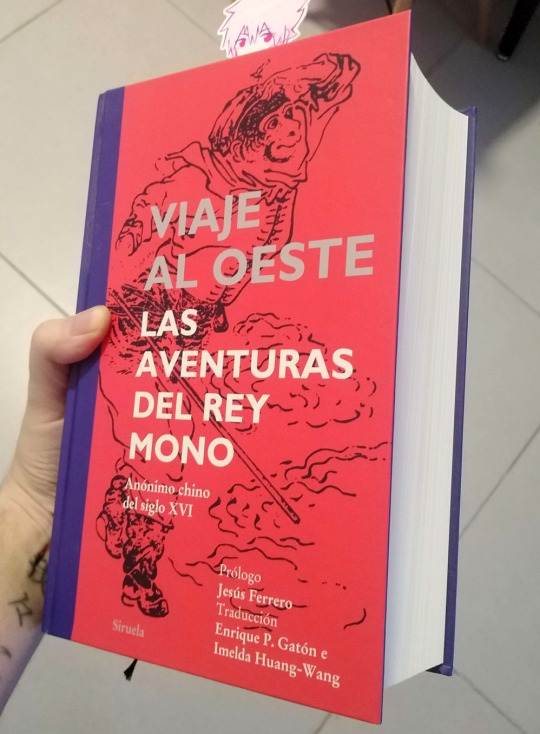
(Cover says Journey to the West: The Adventures of the Monkey King. It's in spanish.)
My guess is that Izana and Kakucho studied about it or read some chapters in school, 'cause dang, there's no way they read all of this at that age?!?! BUT ANYWAY.
While there's obviously quite some buddhist influence in the story, most of what it works with throughout is rooted in chinese folklore and Taoism. The edition of the book I have even begins with extensive notes and introductory explanations about Tao, as its themes of harmony with the universe, self-cultivation, internal alchemy, its main ethics and values, etc etc etc are the basis from which the book is built up. The characters very actively engage with Tao. Sun Wukong is an ardent student of Tao who obtains a bunch of powers through it, for one.
I've gone into this much into detail because Kakucho and Izana make it pretty explicit that, to them, Izana is like monk Tang Sanzang leading to Tenjiku, and Kakucho is like his guardian of unmatched strength, Sun Wukong.
In the end of Journey to the West, it's both Tang Sanzang and Sun Wukong that accomplish their goal and also obtain enlightenment, finally ascending to buddhahood. Had Izana and Kakucho's journey with Tenjiku reached their original destination (not "to become a criminal syndicate that controls Japan" but "to build a kingdom where everyone without a home could exist"), had it been like Tang Sanzang and Sun Wukong's pilgrimage… they would've learned true balance and they would've found the necessary enlightenment.
Again, I find this little connection with characters that could've been on a quest towards buddhahood, but as far as things went in the main TR timelines, all failed.
- Uniform & logo.
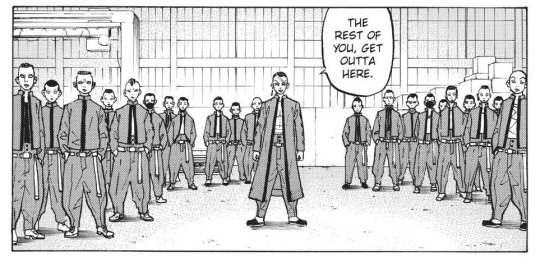
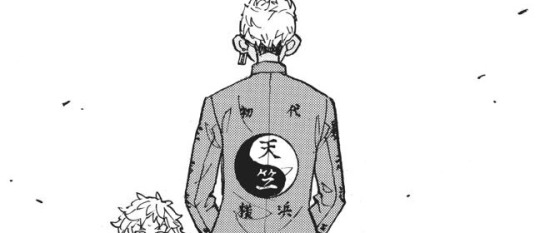
Finally, something lighter and quicker to add, haha.
There are symbols and references that are so so so widespread that they become more of an aesthetic detail than a symbol with meaning, in the eyes of the general public. The yin-yang is one of those symbols that just… appears in a lot of places, fashionably, and one kinda gets used to seeing it without thinking much about it. Sometimes it's not meant to stand for much more than a decorative detail, yes, that definitely happens, but sometimes it's very much a thoughtful choice. With Tenjiku, given its connection to Taoism, I'm gonna treat the yin-yang as a meaningful choice.
So! On the back of the uniform we have a yin-yang, Taoist symbol that represents the balance of the two complementary and opposing forces of the universe (note: it's not a good vs evil type of thing, as tends to happen with western black-white dualism, but rather… the fact that reality needs to be composed of push and pull to get anywhere, hard and soft things with their own function, sun and shade. A common comparison is how a mountain will have a sunny side and a shady side when looked at in a certain moment, but the sun and shade will switch over at another time of day, in a needed cycle). Other features of the uniform are a mao collar instead of a more common style for gang jackets, and an intense red color, the main auspicious and prosperous color in chinese culture. These last two little features could easily be coincidental, but when paired with the yin-yang, I feel like it's intended to lean towards chinese aesthetics.
And with that,
I end this reference post!
Did you learn anything you didn't know? Did you enjoy learning it? Any thoughts? I LOVE TO TALK ABOUT THESE THINGS, SO FEEL FREE TO DROP BY MY ASKBOX with any comments or questions or such!!
#tokyo revengers#tokyo revengers meta#tokyo manji gang#toman#tenjiku#kurokawa izana#sano manjiro#izana kurokawa#manjiro sano#mikey#kakucho#thoughts and talk and so#tokyo rev#wanted to write this one forever#just never quite got around to it
166 notes
·
View notes
Text
'Friends in Unexpected Places' a Yae Miko x Reader drabble!
Dunno if I'd say this is Miko x reader, more so a Miko and reader interaction, but it can be read either way!
Gender neutral reader (one who is a little silly and chaotic), a few pet names used by Miko (little one, dear, darling). Generic mischievous Miko shenanigans!
The trek up to the Grand Narukami Shrine is long and arduous, as it always is. Despite being lauded as one of the most important shrines in Inazuma, the stairs aren’t exactly in great shape.
Not for the first time, you wonder if there’s some kind of secret elevator shaft somewhere that Yae Miko simply never bothered to tell you about - you wouldn’t be surprised, considering how difficult it is to get up here individually, let alone carrying the heavy supply crates that regularly get delivered to the shrine.
You wipe some sweat from your brow as you emerge onto the mountaintop plateau and look out over the railing at the sprawling landscape, so far below that you feel a little dizzy. If you narrow your eyes, you can just make out the dark smudge of Ritou in the far, far distance, and a cursory glance a ways off to the left presents Inazuma City in all its glory, though it’s so far away that the details are nigh on impossible to make out
After taking a few minutes to regain your composure, you approach the temizuya and perform the cleansing ritual that Yae Miko had shown you upon your first visit to the shrine, making sure to perform the steps in the right order before setting the ladle back down.
You were here today at the Guuji Yae’s behest - she’d sent you a letter inviting you for afternoon tea, but by the looks of things, she’s not here at the moment. You can’t help but feel a little disappointed, but you come to terms with it quickly. The head shrine maiden is a busy woman, the fact that this is the first time she’s ever been late to one of your catch-ups is a miracle in and of itself.
Your shoes tap softly on the wood beneath your feet as you pass by a shrine maiden, who leans forward in the small booth she’s situated in and smiles politely at you. “Would you like to draw a fortune slip?” She asks, gesturing towards a small bamboo container in front of you.
You pause for a few seconds, mulling it over. Well, you’ve got to try and fill your time with something. “Sure.” You offer a small smile to the woman, who returns it wholeheartedly.
“All you have to do is pick up this cylinder, and shake it until a bamboo slip comes out.” You do as she asks until the slip falls out into your open palm. “Now pass it here, and I’ll give you your fortune.” You offer the slip, and she exchanges it for a carefully rolled up piece of paper.
You delicately unfurl it and take in the words written there. ‘Friends can be found at the most unexpected times and places.’ You furrow your brow at the vagueness of it.
“If it’s a bad fortune,” The shrine maiden tells you, a slight frown pulling at her features. “You can tie it up over there, that may help change your luck.”
“It’s not a bad fortune, don’t worry.” You look up at her. “Thank you, though.”
“Of course.” She smiles and dips her head, and you turn to walk away, rolling up the slip of paper and putting it in your pocket.
You walk back the way you came, hoping that perhaps you’ll be able to spot Lady Yae coming up the stairs (though you’re not particularly inclined to believe she’d ever do such a tiring thing without good enough reason).
You’re brought to an abrupt stop as your foot collides with something semi-solid, and a sharp yap comes from below. Quickly, you look down to see a fluffy little creature giving you a most offended look.
It’s bright pink, but other than that, it looks just like almost any other juvenile fox. “I’m so sorry!” You exclaim, and it gives you a pointed look before turning away.
You kneel down and reach a hand out tentatively, trying to see if it’s injured, but it coolly side-steps away with a flick of its tail.
“What are you doing up here, anyways?” You’ve seen foxes roaming in the areas surrounding the mountain, and on the plains not far from Inazuma City, but never in the shrine itself. You figured it had something to do with Miko’s aura being so intimidating. “Come on, you must be lost.” You give it an encouraging wave and straighten back up.
You’re almost positive that it can’t understand you, but the look on its face seems to border on amused as it plods along beside you, tail wagging back and forth slowly. Before you know it, you’re back at the entrance to the shrine, with a small fox at your heels.
“There you go, I’m sure you can find your way from here.” You gesture to the stairs, barely a stone's throw away. The fox sits down, resting its fluffy tail over its paws and yawning widely, showing off small, sharp fangs and blinking slowly.
“Right. Well.” You turn on your heel. “Bye.” You’re not sure exactly why you’re talking to a fox, but it’s not really the strangest thing you’ve done, you don’t think.
From the corner of your eye, you see the fox stand, and watch its fur shift as it stretches languidly and flicks its fluffy tail. It pauses for a few moments before turning and padding after you once more.
You stop in your tracks, and the fox stops with you, staring expectantly at you and tilting its head to the side.
“I don’t have any treats for you.” You turn to face it and hold your hands out to show that they’re empty. “I don’t even know what foxes eat.” It’s not an entirely untrue statement - though you know what Lady Yae likes, you feel like actual foxes probably don’t enjoy fried tofu as much as she does. Actually, you don’t know if anyone enjoys fried tofu as much as Miko does.
You’re momentarily distracted as a shrine maiden walks by and casts her gaze over you, then the fox. Something close to amusement passes over her face, but she continues on her way without a word.
“Go on. Shoo.” You wave your hand towards the exit, but the fox just stares at you unblinkingly. “You can’t stay here. You’re going to get stepped on.”
The look it’s giving you almost feels like one of amusement, though you don’t know if foxes can even feel amusement, much less express it so openly. It takes a few steps closer to you and sits down, lifting one front paw to nudge at your foot insistently before giving a soft yip.
“If I carry you down part of the way,” you bargain, as if this ridiculously coloured creature can possibly understand you. “Will you go the rest of the way on your own?”
The fox cocks its chin up and lets out a little huff that you take to be an affirmative answer.
You kneel down and hold your hands out, but the fox just stands there, watching on with judgemental eyes.
“Come on.” You twitch your fingers at it, and one of its ears flicks down for a brief moment. You try making a few little kissy noises, as if calling for a cat. The fox just shifts its weight and wraps its tail around itself, watching you expectantly. “Pspsps.”
It noses into its chest fur for a moment, nudging a tuft that was sticking out back into place. You take the opportunity to shuffle forward a little closer, wondering if this might just be an absolutely absurd idea. The fox leans towards you, and you awkwardly wrap your arms around it.
It’s like a strange, uncomfortable mix of lifting a dog and lifting a cat, mixed in with handling a ferret. The fox seems to suddenly be all lanky limbs and fur so silky soft that it’s hard to keep a good grip.
The fox lets out an aggrieved puff and adjusts itself, giving you a little warning nip as you try to steady it by placing a hand on its haunch. It takes a few awkward moments until the fox is settled in your arms, curled up close to your chest with its tail dangling off of your arm. It tilts its head up towards the entrance, and you begin walking, taking it a little slower so that the fox you’ve found yourself taking care of won’t get jostled about too much. It’s heavier than it looks, like its body is denser than most animals. It’s a bit of an odd feeling.
“You know, I didn’t think foxes would be this soft.” You observe aloud, rubbing a little tuft of fur between your forefinger and thumb.
The fox turns its nose up, seeming affronted.
“I didn’t mean it like that.” You say, as if the fox can actually understand you. “I just thought maybe foxes would feel more like dogs.”
Suddenly, the fox shifts its weight, and you pause on the steps, worried about it accidentally falling. You grimace as it presses its paw down on a particularly tender spot on your arm, pushing all its weight down until you flinch slightly. “Ow!” You complain.
The fox then stops abruptly, curling back close to your chest with a sniff of disdain. You can’t help but feel like it was trying to punish you.
You walk down the stairs in silence until you come to a small plateau of grass. You kneel down to set the fox back on the ground, but it doesn’t seem to want to. You try to awkwardly get it to roll out of your arms and deposit it on the ground, but it moves with a slinky, lazy sort of elegance that makes it impossible.
“Come on, it’s time to go.” You complain. “I’m meeting with someone, and she will never let me hear the end of it if I’m somehow even later than she is because I was babysitting a pink puffball.”
Even as you straighten your arms out, the fox rolls and contorts in a way that almost definitely should not be possible while keeping its spine intact.
“Are you Miko’s pet or something?” You ask, beginning to become frustrated with the increasingly difficult behaviour the fox is exhibiting. “You’re just as difficult.” This statement is met with a sharp nip to your fingertips, and you suck in a pained breath through your teeth. “Are you made of her fur sheddings? The way you’re sticking to me, I wouldn’t be surprised. Come on, shoo!”
You feel worry begin to patter in your chest at the idea of being late for your afternoon tea, but you still can’t seem to manage to untangle yourself from the little fox that has become so attached to you. “Fine then, you can come to afternoon tea with me. And I won’t say anything to defend you when Miko bullies you for being a scrawny little kit.” This statement is met with another bite to your upper arm, sharp little teeth sinking into your clothing.
“Stop that!” You exclaim, standing up and walking over to sit on the stairs. The fox drops into your lap, showing no trace of its previous determination to stay wrapped up in your arms. It curls up on your thighs, stepping on just about every sensitive spot you have with its full weight before it finally settles and looks up at you with big, dark purple eyes.
“You must be Miko’s pet.” You observe. “Only she would get her hands on a fox that looks just like her.” You shake your head and sigh. The fox continues to stare at you. “But even so, that won’t stop me from pulling your tail.” You wrap your fingers tentatively around the bundle of fluff, though you don’t have any real intention of pulling on it at all. That just feels too mean.
You stop in your tracks as you hear a noise on the wind - a faint chuckle, one that you recognise all too well. Every muscle in your body stiffens as you look around, searching for the source. “L-Lady Yae?” You call hesitantly, brow furrowing in confusion.
“Oh, little one.” Her voice is a little clearer now, and you feel the weight in your lap shift and disappear. Oh, now you go running off. You roll your eyes. Her laughter comes again, and with it, a heavier weight dropping in your lap.
You jump in surprise as, in a blur of pink, red and white, Miko herself all but appears in your lap, her arms wrapped around your neck and legs thrown off to one side.
You hold yourself tensely, a little unsure of what the appropriate way to react would be. “It’s…uh…nice to see you?” You hazard tentatively, casting your gaze around the small landing you’re on.
“And you, dear.” She coos, twirling loose parts of your clothing around her fingers.
“Did you…uh…see where that fox got to?” Despite the squabble, you can’t help but feel a little worried for the small creature you’d briefly taken under your care. “Is it a pet of yours?”
Miko throws her head back and laughs, a high and breathy laugh, more open and expressive than she ever allows herself to be normally. “The fox.” She echoes, shaking her head and focusing her intense violet gaze upon you. “Darling, you wouldn’t recognise a youkai if one haunted your house.” She traces her fingers down your cheek in a playful manner. “Or if it bit you. Quite literally, might I add.” She moves her hand from your cheek to your upper arm, then to your fingertips, where the fox nipped at you.
“Wait, what do you mean?” Despite feigning ignorance, you feel the apprehension dawning as clear as day. “You…that wasn’t…You’re not…?”
Miko gives you a fangy grin. “Oh, did I neglect to show you my fox form?” She teases, the symmetrical dimples beside her eyes deepening as her grin just grows at your shocked reaction. “Silly me.”
You sputter for a few moments, unable to get together the words to express how you’re feeling or what to do to rectify the fact that you had just babied fox-form Miko, and talked badly about her to her face. “I-I…” You begin, only for Miko to interrupt you as she presses one perfectly manicured finger against your nose.
“I’ll admit, your reactions were quite amusing.” She informs you. “I think you’d make quite an interesting light novel protagonist.”
“Did you do all of that just to…to prank me?” You ask, feeling a little taken aback at her behaviour, though it’s far from unexpected at this point.
Miko crinkles her face up in amusement. You feel a tug on one of your pockets, and before you know it, she’s unravelling the fortune you pulled earlier. “Friends can be found at the most unexpected times and places.” She recites with a sly wink and a mischievous grin on her face.
Please don't repost, steal, copy or otherwise plagiarise my writing! I do not consent for my works to be translated and posted elsewhere, or used to teach bots!
#genshin x reader#genshin impact x reader#genshin imagines#genshin self insert#my writing#genshin headcanons#genshin fluff#platonic genshin x reader#yae miko#genshin yae miko#yae miko x reader#yae miko x you#miko x reader#yae miko x y/n#yae miko fluff#platonic x reader
164 notes
·
View notes
Text

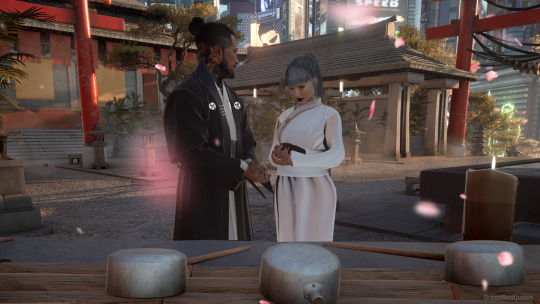
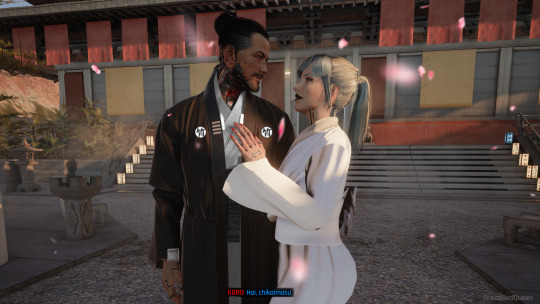
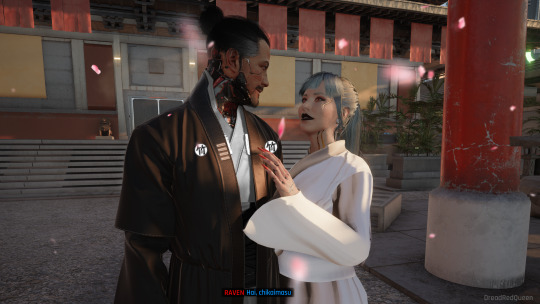
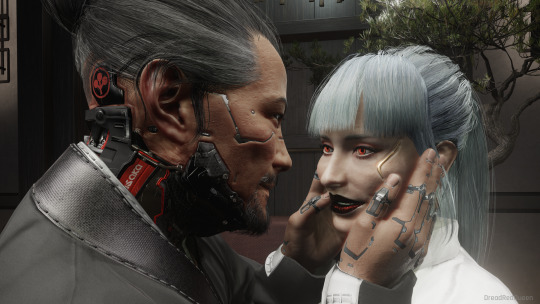
🚫 Do not re-upload/edit my shots/art without my permission🚫
Raven & Goro's Japanese Wedding
the 1st screenshot is them at the Temizuya where they cleanse there hands and mouth to purify themselves
I couldn't figure out how to get a shot of them offering the Sakaki (this is offering a branch from the sacred tree to the gods usually food and Saki are also offered)
I also couldn't get a shot of them during the Sansankudo
Sake drinking or sansankudo = Three three nine times is the literal translation of sansankudo. An integral part of a Shinto wedding ceremony involving drinking sake The physical act involves three cups, one small, one medium and one larger. The sake is poured from a special vessel that looks like a teapot. Each cup is poured in three increments. The groom sips three times from the small cup first, the bride follows. The bride then sips from the medium cup three times and the groom follows.
then there vows and of course Goro kissing his new bride though that bit I added myself I'm unsure if they kiss there brides like in a western wedding.
"Hai, Chikaimasu." = I promise (basicaly this is like saying I do) this is in reference to there wedding vows.
Ravens kimono would be referred to as a shiromuku (this is a pure white silk kimono) and Goro's that I photoshopped is referred to as a Montsuki (this is a formal black kimono with white inner layers usually 5 layers in total, the family crest on his shoulders is the Kanji for Bamboo (Takemura) and the Kanji for Feather nestled inside representing Raven. I took some liberty here, as they decided to make there own family crest. normally this crest would of been Goro's family crest but in my story I've gone with him not having a family crest due to coming from a poor background and Raven suggesting they make there own, in a sweet moment between them
please if I have got anything wrong let me know, I did alot of research into tradition Japanese weddings so if I have misinterpreted or got something the wrong way round or translated anything wrong do correct me in the comments
#goro takemura#cyberpunk 2077#takemura#goro#takemura goro#oc: raven#oc: victoria rominov#japanese wedding#wedding#photo edit#daily gaming#gameing edit#in game photomode#virtual photography#photo story#photo set#takemura romance#goro takemura wedding#no relic au#assassin#white haired women#cyberpunk 2077 photomode#cyberpunk 2077 in game photography
20 notes
·
View notes
Text
🇯🇵⛩️Japan day 9 - last day of the road trip
Today we visited Ise, birthplace of Shintoism and home of Japan's most important shrine to Amaterasu-Omikami, the sun goddess who gave birth to the Imperial line.
⛩️Ise-Jingu is an immense shrine spanning the entire region, and containing 125 small shrines. The most important one is Naiku, the one where Amaterasu-Omikami is enshrined. Historically the high priests and priestesses of the shrine belonged to the imperial line, and the current high priestess is the daughter of retired emperor Akihito. The entire shrine (like, the main buildings, torii, etc, the whole shebang) is rebuilt anew every twenty years; the operation takes nine years and involves hundreds of rituals.
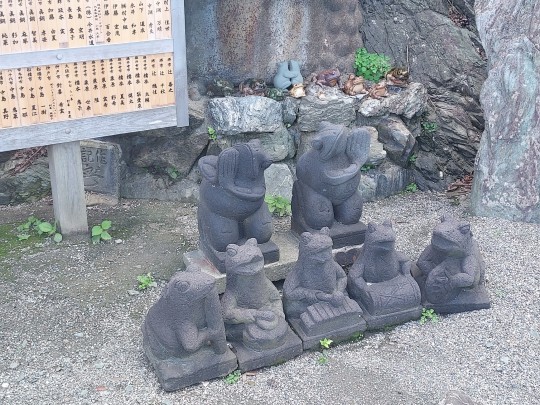
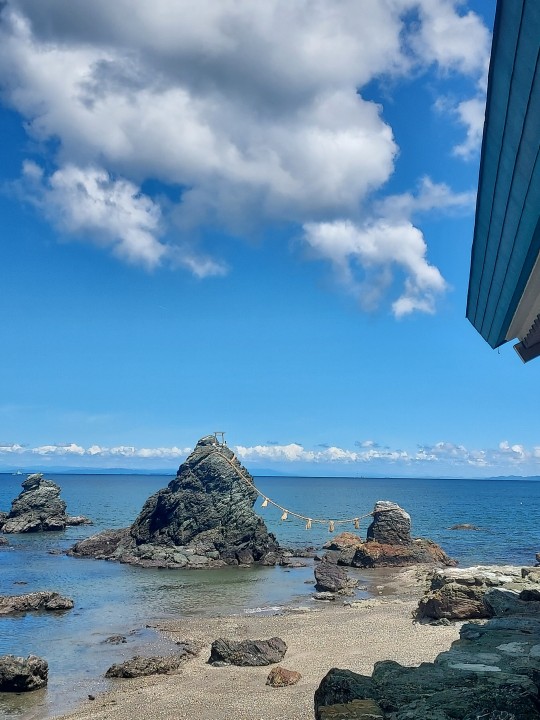
Ise shrine has been an important place of pilgrimage since the Edo era. The traditional route is to first purify yourself at Futamiokitama shrine, home of the famous Meoto Iwa "married stones", where young women pray for an auspicious marriage. The rocks represent Izanagi and Izanami, the original gods and parents of Amaterasu & co. The enshrined kami, Sarutahiko Okami, has frogs for their messenger animal, and there are frog statues and frog-decorated merch to buy. I nearly bought a tadpole-shaped omamori (might go back tomorrow for it).
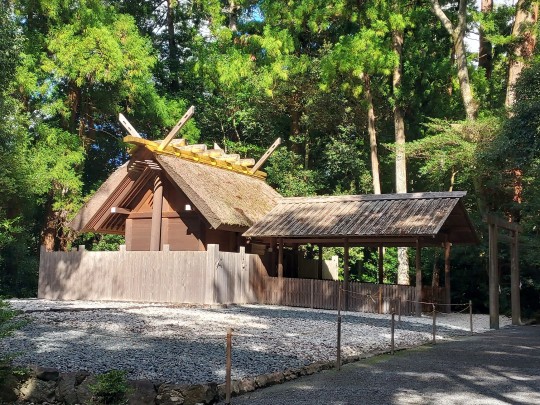
Then you visit Geku shrine, dedicated to Toyouke Ohime. She is the goddess of food, clothes and homes. She was summoned and enshrined in Ise after an emperor had a vision of Amaterasu basically saying "I love it here but there's no food, bring my pal over so she can cook for me".

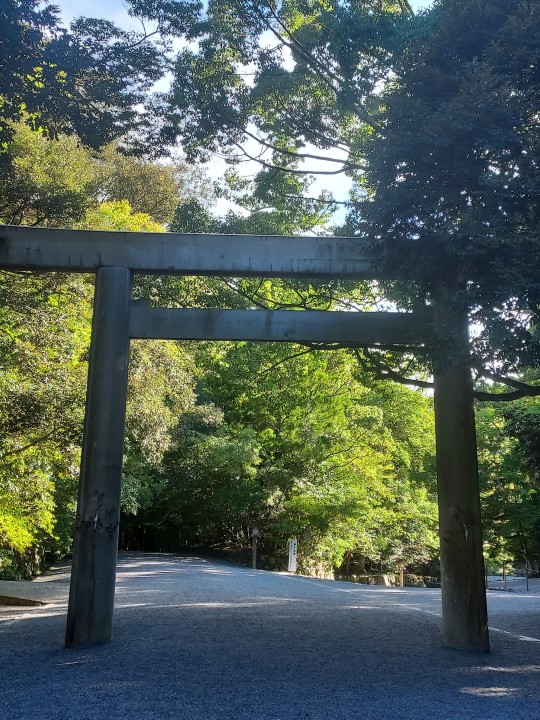
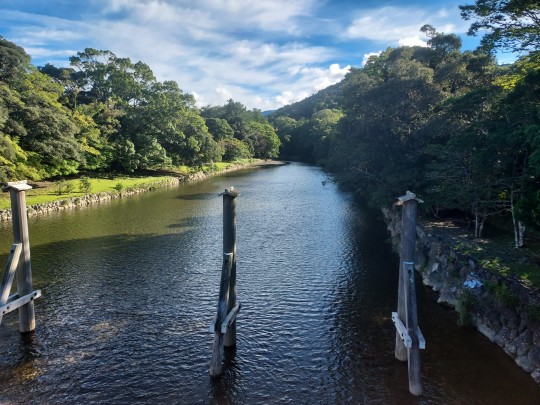
And lastly, you visit Naiku shrine, home of Amaterasu the sun goddess, protector of Japan. You can even ourify yourself djrectmy in the river rather than in a temizuya.
The shrines themselves were a little underwhelming, especially when compared with the other shrines I've seen so far. All of the buildings were made of plain wood, which is logical when you account for the fact that they're rebuilt every 20 years. You also cant see the atars, which are hidden behind walls or cloths, and there are no statues.
On the other hand, plain wooden buildings shaped like rice granaries in the middle of a forest /does/ bring you closer to nature, which is the origin of shintoism (which is at heart an animist belief). All in all, it was a important place to cross off the bucket list.
Also, tonight I can sleep on a real mattress for the first time in 10 days 🥳 And tomorrow we head back to Tokyo.
14 notes
·
View notes
Text
Am I getting confident?!
Since I had tea school the day right after the Grand Tokyo Tea Ceremony, I have not put my thoughts on record right after the practice as usual. There was a lot going on these days.
But tea school was really calming. Especially since I got to practice with the same utensils like last time, because we practice for the event in December. And this will probably continue until the end of the year.
This is very unusual, since tea ceremony follows the seasons a lot! But to be honest: getting to know some utensils in this way and becoming familiar with them, is an interesting experience as well. And I made less mistakes than last time. I will be so brave to say: I might be confident to do the event without mistakes.
Besides that I have only two side notes:
1. Coincidentally, my skirt matched the manju of that day. I liked that a lot. Also this is a new skirt and it’s perfect for practices (some skirts can get really annoying lol).

2. I made a photo the temizuya where we clean our hands and mouth before we join the practice. There is no reason why. I just never did until now but somehow thought on that day, why not take a picture. So here you go.

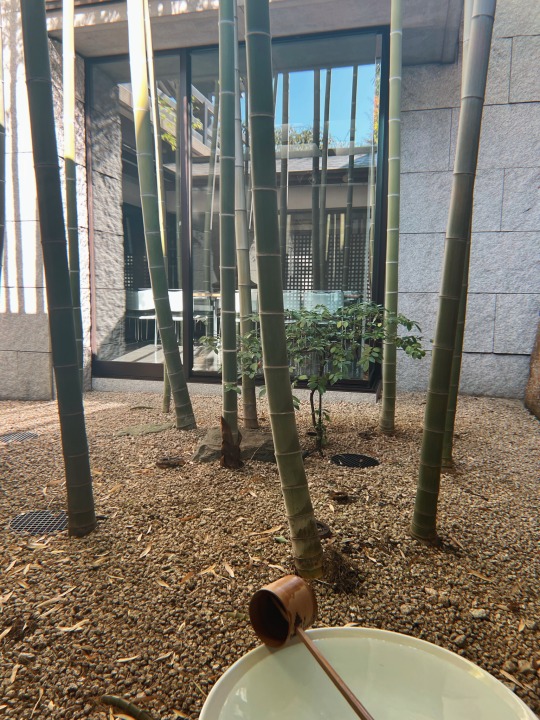
9 notes
·
View notes
Photo
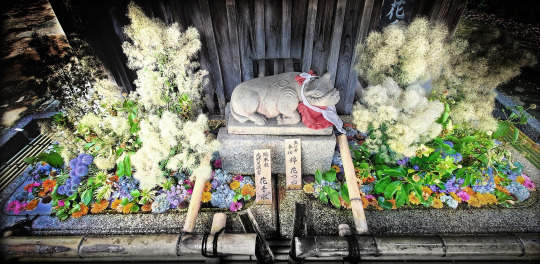

Hanatemizu at Kitano Tenmangu Shrine, Kyoto, Japan. 'Hanatemizu' refers to the coloured flowers floating in the Temizuya, the basin used for cleansing rituals at.
130 notes
·
View notes
Text
[ for @fallesto // from here. ]

he'd only just finished his supper when he hears someone on the other side of the shogi. a soft footfall, no louder than a sigh of wind — but just enough to betray the presence of a disobedient little mouse. the holy one wipes his mouth on the back of his hand, leaving streaks of precious blood behind, blood which he eagerly swipes clean with his tongue : and by the time he has approached and pressed a keen ear to the aging paper, there is only silence on the other side. but a scent lingers there, the scent of old bruises and japanese primrose and mother's milk — 𝐊𝐎𝐓𝐎𝐇𝐀.
cleaning up is a simple ordeal, a ritual no more strenuous than washing his claws in the temizuya or reciting the lotus sutra : douma is a quick and efficient predator who knows how to do things quietly and calmly. when things go well, it's effortless, almost second nature to him — and when they don't, it's A BLOODBATH. fortunately tonight's meal was particularly well executed, and the remaining bones and offal are swiftly hidden away for later consumption before he exits his chambers in search of his newest sheep.
kotoha is barely strong enough to nurse her child, let alone wander the vast halls of his temple unaccompanied — and at night, no less. she had been inches away from ruining everything. this thought is not lost on him, and so he resolutely chides her when he finds her attempting to feign sleep in her own quarters. her thoroughly disheartened expression and fervent apology cause his ire to simmer : she had meant well, in her human naïveté, and such a fearful response to his anger will guarantee that she won't make such a mistake again. the divine heaves a sigh, allowing his shoulders to sag as his anger ebbs away like a receding tide — what a strange power she has ; no human has ever stirred such a sensation in me.

❝ i appreciate your concern, little lotus, ❞ douma croons in a soft, almost apologetic tone as he sits in seiza beside her, one clawed hand reaching out and stroking through her silky ebony locks. ❝ but you needn't worry about me. stay here with your child when it's dark outside : the temple is very easy to get lost in at night, and that is very dangerous for someone as injured as you are. rest assured that if i need you, i will come to you. ❞
his wickedly-sharp talons just barely brush the swell of her bandaged cheek, a feather-light touch from cold murderous steel. kotoha doesn't flinch away, a testament to how much she already trusts him. she is healing well, and the holy one won't be able to use her convalescence as an excuse to keep her shut up at night much longer. on the futon behind him, inosuke stirs and gurgles : without a second thought, upper two reaches out to tickle the infant's chubby belly with those same daggerlike claws that had slit the throats of three women only an hour ago. the boy giggles almost melodiously, and something kindles to life in the divine's empty chest.
it feels like a heartbeat.
❝ is there anything i can do for you now that i'm here with you? are you hungry? you didn't eat much at the evening meal tonight ; are you feeling all right? ❞
2 notes
·
View notes
Text
Yamazaki
Inicialmente seria um desafio das décadas, porém eu perdi esse save muitas vezes, então desanimei. Mas eu amo muito meus sims e resolvi retornar, embora seja mais um desafio de atingir dez gerações, mesclado com o das décadas. Estou seguindo as regras atualmente dos anos 1900, a Era Eduardiana.
A minha família é japonesa e seguem a religião do xintoísmo. É uma família em ascenção, que mora em uma mansão herdada — mesmo que tenham dificuldade para pagar as contas.

Pela esquerda começamos com a Ryuu, a terceira filha do casal principal, ela é uma jovem que busca um casamento que orgulhe a sua família e seja proveitoso.
A bebê do mesmo lado é a Harumi, a quarta filha. Ela é uma adorável menina que vive correndo por aí.
Na parte do meio superior temos o Obanai, o primeiro filho, ele é um adolescente reservado, forte e leal a sua família. Ele faria de tudo para defender seus pais e seus irmãos. Embora nos últimos tempos tenha estado silencioso e distante...
Abaixo dele temos o Daiki (sim da @familiaberry/Beatriz), ele é um pai e um marido atencioso, apesar de estar interessado em conquistar laços com estrangeiros europeus que estranhamente chegaram na cidade há algum tempo — não se sabe o porquê deles terem vindo ou mesmo o motivo de não irem embora.
Do lado dele temos a Hikari, a matriarca da família. Ela é uma mulher prendada, doce e calma que ama os seus filhos e seu marido — não se enganem, ela pode se tornar o próprio dragão quando estiver irritada.
Por fim, temos o adorável segundo filho, Kazumi, dono de incríveis e peculiares olhos esverdeados e cabelos negros. A coloração de suas íris é um mistério para sua família, mas também um atributo para os demais. Ele é um adolescente muito gentil, ingênuo e "feminino" demais para a sua época, o que lhe gera muita decepção por não poder orgulhar o seu pai da maneira que deseja.
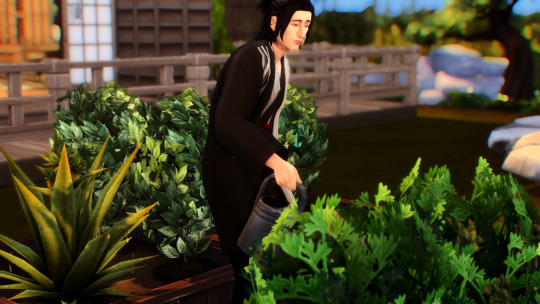
Começamos em um dia regular, Daiki rega as suas plantas pela manhã.

Kazumi e Hikari vão para o santuário em sua própria casa, purificando suas mãos e bocas no temizuya antes de entrar. Kazumi aprendeu desde pequeno que lavr as mãos é purificar o corpo, e lavar a boca é purificar o coração.
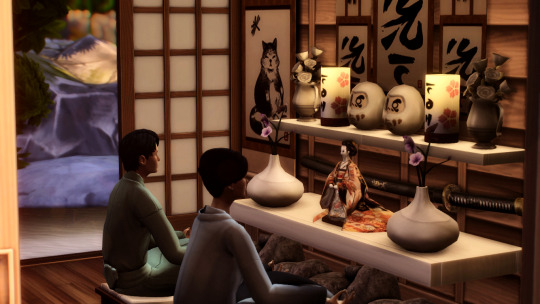
Eles oram aos Deuses para agradecerem por estarem saudáveis e para pedirem um futuro feliz e bem-sucedido.
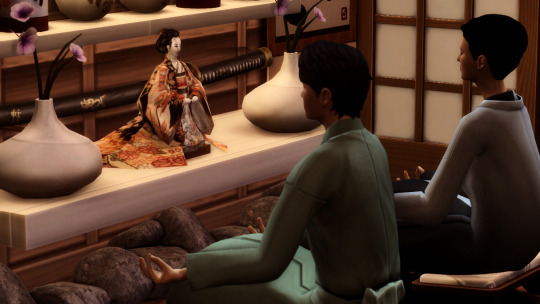
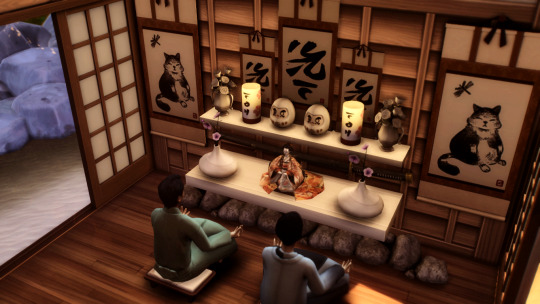
Silenciosamente Kazumi pede para que os Deuses lhe dêem uma chance de honrar a sua família e parar de ser tão diferente dos outros.
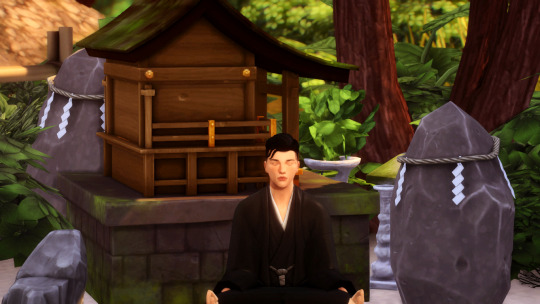
Obanai medita ao lado do santuário do jardim.
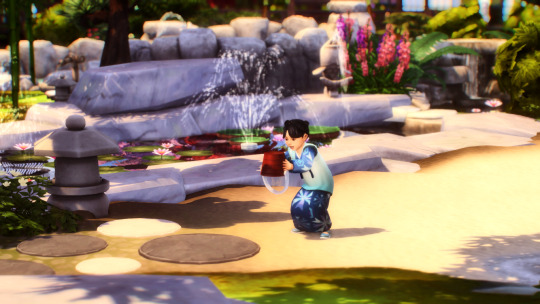
Enquanto isso Harumi brinca.
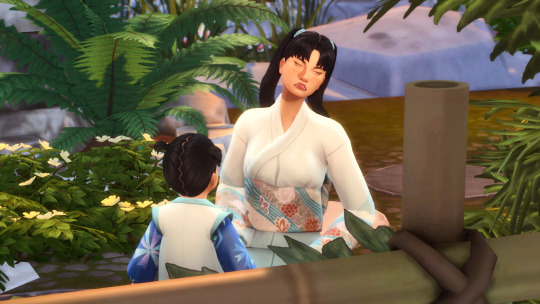
Depois, na sombra de uma árvore Ryuu tenta ensinar sua irmã a falar, porém acho que ela não teve muito sucesso.
PRÓXIMO
6 notes
·
View notes
Text
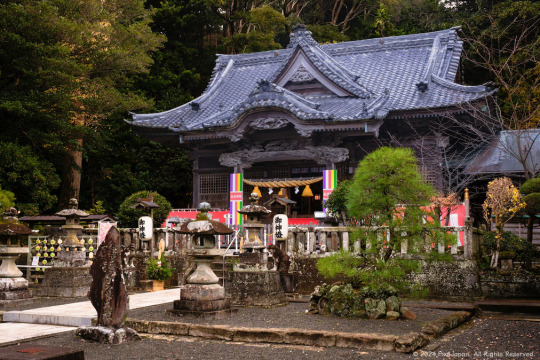
Sacred Spaces and Cultural Grace: Navigating Japanese Shrine Etiquette
Location: Shirahama, Shimoda, Shizuoka, Japan
Timestamp: 07:40 on January 3, 2024
Fujifilm X100V with 5% diffusion filter
ISO 3200 for 1/90 sec. at ƒ/8.0
Film simulation: Velvia/Vivid
Ancient documents dating over 2,400 years reference this shrine, suggesting an age surpassing 2,400 years. Like many Japanese temples and shrines, some structures are reconstructed due to earthquakes, fire, or periodic disassembly for inspection and improvement, ensuring both longevity and the preservation of traditional Japanese building techniques.
The worship hall seen in my photo was last rebuilt in 1860, and the sanctuary on the hill behind the worship hall and housing the deity was reconstructed in 1922.
Visitors during New Year's adhere to traditional steps followed at any time of the year. Regional customs may vary, but general worship practices and etiquettes apply to every shrine.
It is appropriate to dress in a way that is slightly conservative. Just avoid wearing revealing or tight-fitting clothes (such as tank tops, sweats, or workout clothes) out of respect for the cultural setting. Remember, these are sacred sites—not a shopping mall or an amusement park.
When you pass under the torii gate, which marks where the realm of Shinto kami (deity) begins and separates it from the secular world, prepare your mind and your heart, calm yourself, and appreciate everything around you, be it visible or not.
At the torii gate, show your respect by taking your hat off if you wear one and bowing once before passing through.
Be mindful to walk on the left side of the way, as the center of the approach is said to be the “place where the kami pass.”
At the water basin (temizuya or chozuya), purify yourself by scooping water to wash your free hand and then switch the ladle to wash your other hand. Pour some water in your empty hand and rinse out your mouth. Follow the actions of the Japanese around you and will be fine.
Proceed to the main hall for worship. The customary routine involves bowing twice, clapping twice, and bowing once. Make a monetary offering, often a 5-yen coin is used as it symbolizes luck.
Shinto shrines cater to common needs, managing centuries-old traditions and festivals. Japanese embrace diverse traditions without strict religious adherence, enjoying aesthetics like Christian weddings and festivities, and follow Buddhism for matters of the afterlife. These cultural adoptions allow appreciation without religious affiliation.
For those with a keen interest in Japanese approach to religious traditions, I have provided links to useful sources at my latest pix4japan blog post: https://www.pix4japan.com/blog/20240103-shirahama
#風景写真#伊豆半島#初詣#白濱神社#pix4japan#X100V#Fujifilm#travel photography#Japan#Izu#Shimoda#Shizuoka#Shirahama Shrine
10 notes
·
View notes
Photo
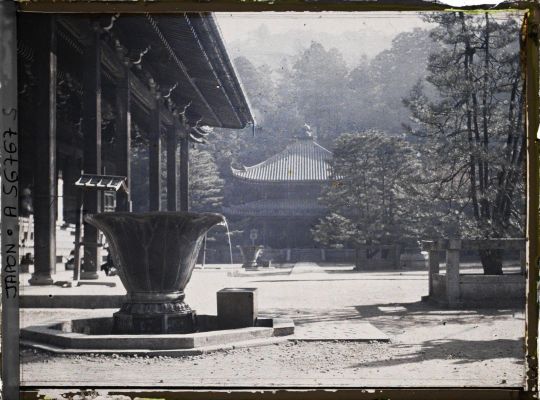
Roger Dumas - Kyôto, Japon. Temple Chion-in: temizuya (fontaine pour les ablutions) devant le hall principal du Chion-in (Mieidô). 1926
1 note
·
View note
Text
Shintoism and Buddhism in my fiction
Japan has two main religions, Shintoism and Buddhism, and with how they are both deeply ingrained in Japanese history, they both appear in my stories. So far, for simplicity and also my own interests, I have kept to Shinto shrines in my stories. However with how interconnected both religions are, it’s hard to keep completely away from it.
In Tales of Yamato I frequently mention shrines, have a few different types, and even in Survival we see different parts of a shrine up close. However, this isn’t the only religion based architecture in Japan. There are plenty of temples and shrines all around the country, and for those who don’t know much about them, it can be easy to mix them up. This is another reason I’ve kept close to Shintoism. Torii gate.
Shrines, and shrine related items such as torii gates belong to Shintoism, and are sacred areas for the gods. They can have other important aspects too such as water close by for purification, as well as a forest. Both of these are seen in the shrine in Survival, eventhough it is now one that is rarely used.
There are also temples, which belong to Buddhism. However both religions have been around in Japan for so long, that even these places share similar things.
Torii gates mark a sacred area, often seen in and around shrines, and made of different materials, from wood to stone. Where they are located can signify the levels of holiness. However, they can also be found at Buddhist temples.
And it’s not just torii which are found at both. The Buddhist romon and soumon are both gates that mark the entrance to a temple, and can be seen at shrines also. It’s not just the larger architecture which is seen too, with many temples also having stone komainu guardians, and temizuya for purification rituals. And to top it off, most layouts of a Shinto shrine is Buddhist in origin, however there are some which predate the Buddhist influence.
And although the Buddhist temples haven’t been shown in my stories, the practices definitely influence and appear. In The Cry of the Raijuu we see a little of food mentions. Through research I have learnt that lower class ate small but frequent meals, and that there was a country wide ban on meat because of Buddhism. It wasn’t until 1868 when the government separated Shintoism and Buddhism and it was lifted.
Despite this separation, the two religions are still connected with each other and play prominent roles in Japanese life. One example is the belief in vengeful spirits, onryou, who died without funerary rites. To pacify their spirit so they stop causing suffering for the living, Buddhist rites are used as well as enshrining them as kami, the Shinto way.
I’ve enjoyed researching and adding different practices in my stories, trying to make them prominent enough for readers to learn about but not stand out in the prose. One of my favourite scenes is when Hotaka visits the shrine in the beginning of Survival. It was tricky to explain to readers what comes natural to him and his beliefs, as well as drop the names for parts of the shrine. The hardest was the haiden as there is no equivalent at all for the West, however for those who read manga or watch anime, chances are you have seen one before. It’s where visitors put money into a donation box, ring the bell, and perform the prayer ritual: two bows, two claps, and a final bow.

Picture from nippon.com. Follow the link to learn more about the haiden.
In The Cry of the Raijuu we also meet a kannushi called Shouhei. He oversees the shrine to Inari, and unlike some other religions, is allowed to have a family and even take on a second job if needed.
Shinto shrines are also only a small part of the religion that I have written about. I also enjoyed adding a festival, and found researching very inspiring. The one I wrote about in Survival was based off the Akita Kanto festival and one I very much want to see in real life, as the video I watched wasn’t enough! No doubt too if there is a chance to add another festival in a future story, I will take it.
Of course the biggest parts of Shintoism which appear in my stories are my favourite parts. The kami and the yokai. I’ll definitely make another article just about yokai as they are numerous and I have much to say about them. As for kami, so far I have only had a small handful of them appear.
I’ve stuck with the biggest named kami such as Amaterasu and Inari, and it’s been great exploring each of their characters. They aren’t just beings which inhabit the world in human form, they inhabit all sorts of matter, living or dead, and also natural phenomenon such as fire, wind, and disasters like earthquakes and tsunami. All kami can be benevolent or destructive, and shrines can help pacify angry gods. There are also some kami who are regarded as destructive or malevolent and prayers are used to dissuade their ire. And if warnings are ignored, or if they act improper towards them, a kami can inflict punishment such as illness or even death. This is called shinbatsu.
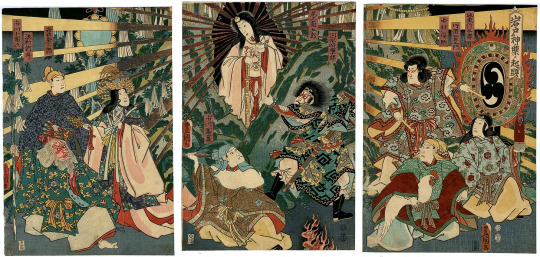
Amaterasu seen on “Origin of Iwato Kagura Dance” by Toyokuni III (Kunisada)
I explored this a lot in Broken Waves with Susanoo and his angry ara-mitama, and how he uses the water for destructive purposes. However, Susanoo doesn’t act in true shinbatsu as it’s all goading from the malevolent ara-mitama. His solution to dealing with her, of finding somewhere safe to purify himself once more and calm the ara-mitama with rites also comes from the Shinto harae (purity). A purification ceremony uses fresh water normally—like seen in Survival at the temizuya—however the most effective and ancient form of purification comes from full immersion in the sea.
In Shintoism there is the importance of avoiding kegare (impurity) and purification rites are used to restore those who are kegare back to harae. This is also a theme I have dabbled in in The Cry of the Raijuu, where they must find a way of purifying the raijuu to stop bad luck from either kami or another yokai such as a shinigami.
I’m still learning a lot about all the different aspects of the religion, alongside the kami and yokai, plus history on top. There is so much information to comb through, but I hope it will all filter through into my stories naturally, whilst immersing you all in Shintoism—with a splash of Buddhism too.
#indie author#historical fantasy#japan#writblr#writing community#original writing#original fiction#Shinto#shintoism#japanese mythology#buddism#shrine#torii#temple#yokai
0 notes
Text
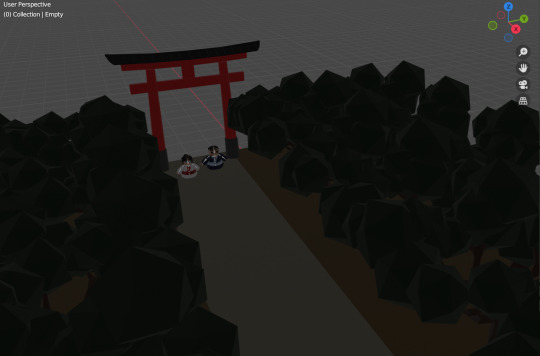




With the completion of the characters, I added some things to the environment. I added emas, which are wooden planks used to write down wishes and hung up near shrines. Another I’ve added is a temizuya, which people use as a purification process before making a prayer.
0 notes